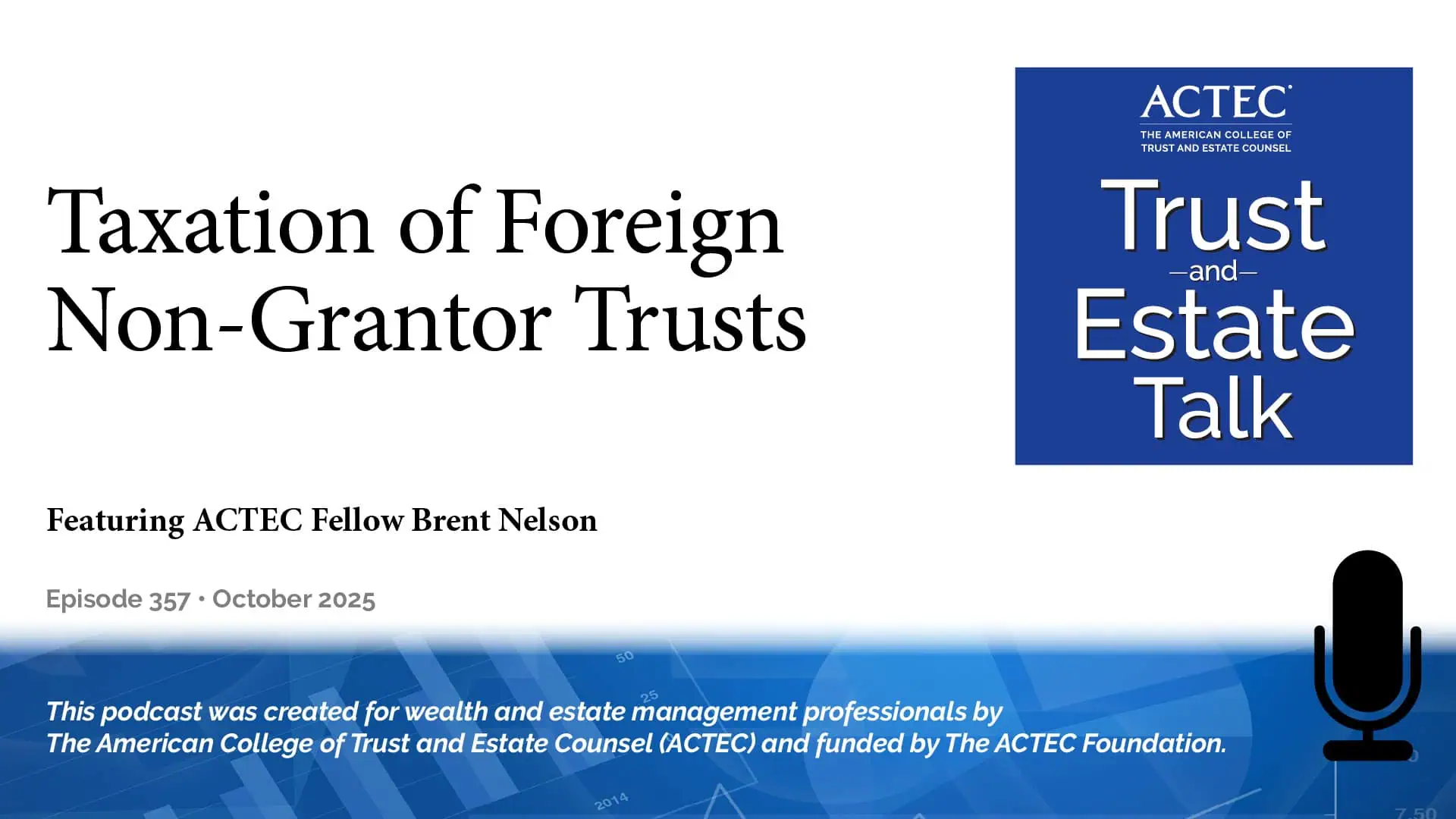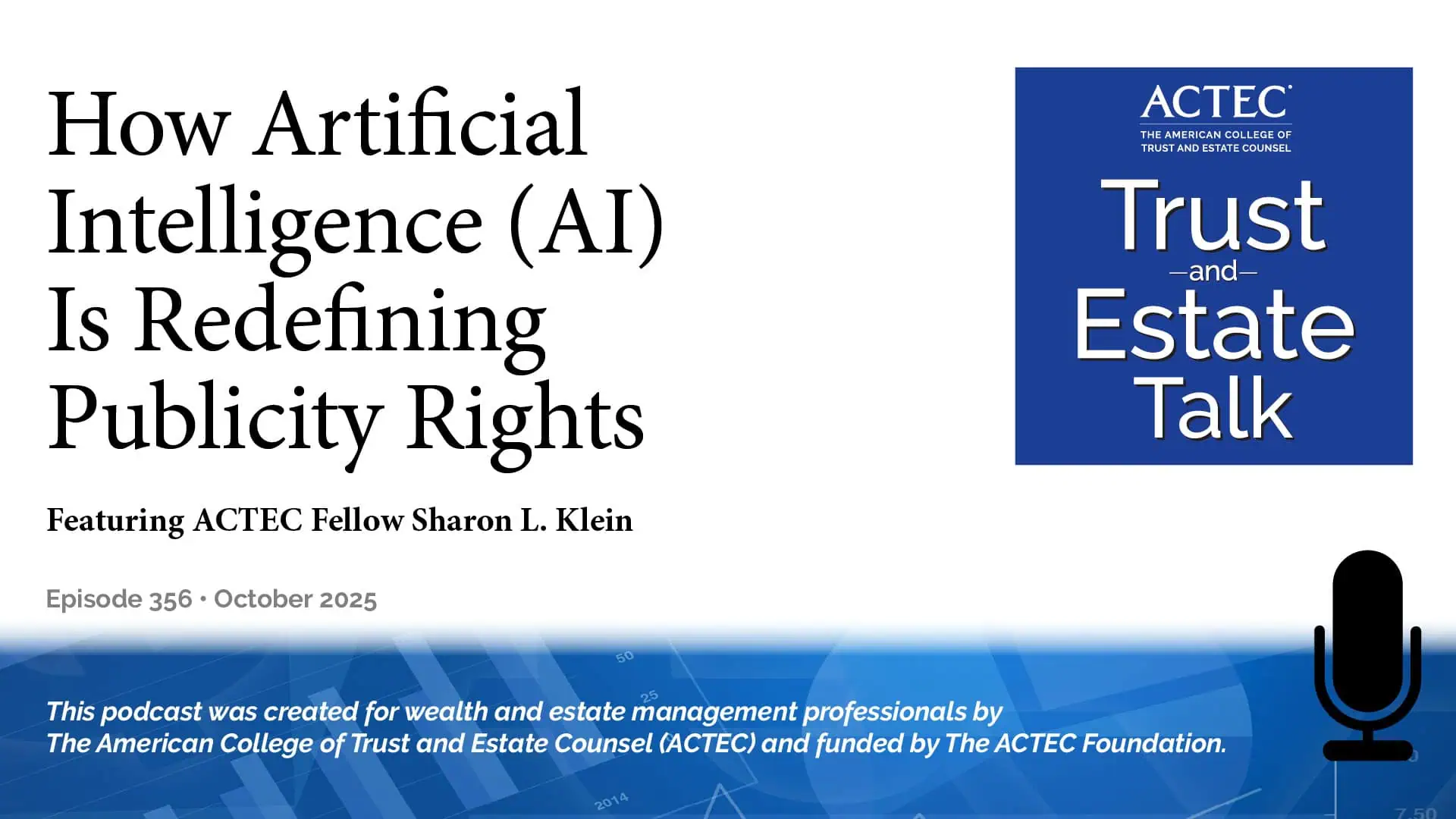Taxation of Foreign Non-Grantor Trusts
“Taxation of Foreign Non-Grantor Trusts,” that’s the subject of today’s ACTEC Trust and Estate Talk.
Transcript/Show Notes
This is Travis Hayes, an ACTEC Fellow of Naples, Florida.
In this podcast, we will unravel complex cross-border estate planning topics for today’s global families. Whether you’re an advisor, an expatriate, or a trustee navigating compliance, today’s speaker will clarify the U.S. tax rules that come into play when foreign trusts have U.S. beneficiaries or U.S. assets.
ACTEC Fellow Brent Nelson of Tucson, Arizona joins the podcast today to educate us on what makes a trust a “foreign trust,” the differences between grantor and non-grantor status, and the pitfalls that could trigger major penalties. Welcome, Brent.
Understanding the Taxation of Foreign Non-Grantor Trusts
Brent Nelson: Thanks, Travis. This is a pretty important topic for cross-border families and it’s one of those topics that can arise without anybody really trying to do anything – it can just happen. And so, I think the easy way to do that is to walk through a hypothetical that will illustrate this point, and then from that, I’ll draw out some of the pertinent information and some planning ideas that people need to keep in mind.
Let’s imagine that there is a non-citizen, non-resident grandfather. And it doesn’t really matter what country he lives in, but let’s just say he lives in a country that’s not the United States; he’s never going to be a U.S. resident for income or transfer tax purposes. And he creates an irrevocable trust outside of the United States with a non-U.S. trustee many years ago. And, at the time, none of the family members were U.S. people. Nobody lived in the U.S. Nobody really had any true connections to the U.S. However, now, all of a sudden, one of the grandchildren moves to Miami to get a job with a tech startup in the Miami tech scene. And, of course, all of our Fellows in the Bay Area are thinking – “So this is a grandchild who’s got a spendthrift problem because they’re not even serious about tech moving to Miami.” But setting that aside, you have this scenario where the trust, which used to have absolutely no contact with the U.S., is now connected to the U.S.
The rules I’m about to describe are American rules, they really apply to U.S. people, primarily. Before this event happens and the grandchild moves to the U.S., these rules are sort of irrelevant. Let me describe ways that we can then analyze this structure so we can come up with a solution, hopefully, for this family.
What Makes a Trust “Foreign”?
First of all, you have to figure out whether or not this trust truly is a “foreign trust.” That’s one of the things that you mentioned, Travis, in the intro. That’s pretty easy in this case because if you have a foreign trustee that has substantial decision-making authority over the trust, it is a foreign trust, even if all of its assets and beneficiaries and settlors are in the United States. That alone will make it a foreign trust.
Distinguishing Between Grantor and Non-Grantor Trusts
Then we have to analyze whether this trust truly is a grantor trust versus a non-grantor trust. The distinction being, really, the taxation of the U.S. beneficiary. A foreign trust with a foreign settlor is always going to be a non-grantor trust unless one of two things is true:
- The settlor of the trust or the settlor’s spouse are the only beneficiaries who can receive distributions during the settlor’s lifetime.
- The settlor has the power to revoke the trust.
If those two things don’t exist, then it is a non-grantor trust.
Planning Before a Beneficiary Becomes a U.S. Resident
Very easily, foreign trusts can become non-grantor trusts. That part then makes us think – “Well, what can we do before this child takes up residency in the U.S.?” We have to know in that case and analyze – When is the beginning date of that child’s residency for income tax purposes in the U.S. Or are they really going to be resident in the U.S. during the calendar year? Will that be in a subsequent year? We have to think, is there a way that we can manipulate the trust so that it’s either a non-grantor trust or a grantor trust, depending on what we want? And I’ll describe what happens if it’s a non-grantor trust, meaning we might want it to be a grantor trust. We should think about whether we can divide the trust. So maybe we have an American side or American share for this U.S. beneficiary and then a foreign share for foreign beneficiaries. And then we should think about if the trust owns any assets that are foreign assets, whether we can “change” those assets.
Key on those lists would be things like interests in foreign companies that might be able to “check the box” under the check the box regulations under Section 7701 – that would cause the entities to become non-corporations, non-foreign corporations for U.S. income tax purposes. That’s usually better for U.S. beneficiaries. If we can take those prophylactic steps before this trust is subjected to these fund rules I’m about to describe, then that usually is best. We have to think about all of these in our analytical framework.
Understanding Grantor vs. Non-Grantor Outcomes
Now that we’ve gotten done with the trust level, let’s assume that you’ve worked your way through those issues. Now you have to think about the beneficiary. If the trust is a grantor trust, then of course you have to figure out who that is, who is the grantor, who is the “deemed owner,” in the terms in the grantor trust rules. If it’s a foreign grantor and it’s a grantor trust, then that foreign grantor is the taxpayer. And if the trust has no income in the U.S., then that foreign grantor pays no income tax in the United States and distributions to the U.S. and distributions to the U.S. beneficiary are income tax-free. That is a pretty good result. so that might be the result that we want to get. And that if we can arrange the trust before the U.S. beneficiary becomes a U.S. resident for income tax purposes, that might be what we want.
There is the flip side of that too. If the trust is a non-grantor trust, and we can tell that it’s going to be a non-grantor trust, we could potentially make the U.S. beneficiary the deemed owner by giving that U.S. beneficiary the right to withdraw the trust income tax – taxable income, excuse me – and do that under a Section 678 power. In that case, the U.S. beneficiary would be the deemed owner of the income items of the trust and would be taxable in the U.S. If the trust only has U.S. source income, that doesn’t really cause any true issues. If the trust has foreign source income, then you have to think through the tax, very complicated tax rules that relate to foreign sources of income for U.S. people. That’s a little bit beyond the scope of this discussion.
The Throwback Rules Explained
But let’s say that we can’t make this trust a grantor trust one way or the other. Now the trust is going to be a foreign non-grantor trust, it’s going to have a U.S. beneficiary. For that U.S. beneficiary, a special set of rules applies called the “throwback rules.” And I think the throwback rules are sort of like consoles – you always hear what they are, but you have no idea what they do.
And the throwback rules work this way: throwback rules apply special income tax rules for the trust beneficiary and then a penalty for the trust beneficiary. The special income tax rule is that the trust beneficiary is going to be taxed on the receipt of distributions of distributable net income from the trust at ordinary income tax rates. However, capital gains items are included automatically in distributable net income, different from the normal domestic non-grantor trust rules. You don’t have to say anything special in the trust document to get that result, it’s automatic under the throwback rules. Then when the beneficiary receives a distribution of what’s called “accumulated income of the trust.” So let’s say the trust has distributable net income in one year, but doesn’t distribute all that distributable net income. Now it has accumulated the income – that later accumulated income that’s distributed is not only taxable to the beneficiary, but an interest charge applies from the year that it was originally accumulated as if they had underpaid their tax in the original year. The interest charge, if this is accumulated income over a very long period of time, can be more than the tax amount and can be even more than that accumulated income amount that’s distributed to the beneficiary. So that might not be a great result for the U.S. beneficiary.
Strategies to Minimize Accumulated Income and Penalties
So, what do we do? This is always the question that I think to myself, can we fix this solution? And it turns out that there are a few solutions to this problem.
Number one – we can try to make sure that we control what is in fact being distributed year-to-year to the U.S. beneficiary. If we make sure the U.S. beneficiary is only receiving the current year Distributable Net Income (DNI), then they’re not going to be subject to the accumulated distribution rules and this interest charge. We also want to make sure that we can control the trust accounting income because DNI cannot exceed trust accounting income. And we can do that in a number of ways. First of all, we can create an entity because distributions from the entity are treated as trust accounting income and, therefore, we can control distributions from the entity perhaps. And we can control trust accounting income and then what goes to the beneficiary as distributable net income in the year.
And, finally, we may be able to wrap some of the investments of the trust inside of a non-taxable wrapper like an insurance policy that qualifies as life insurance under the U.S. life insurance rules, where the income items inside that policy are not going to be attributed to the trust or to any of the beneficiaries during the year. But withdrawals from that policy then can be distributed to the beneficiary in the year that you make the withdrawal. So you can sort of control and contain down this issue in certain ways.
Another way that you could contain the issue, of course, would be to make the trust a “simple trust” under the U.S. non-grantor trust rules and say that all net income is going to be distributed to the U.S. beneficiary annually. Of course, that opens up the U.S. beneficiary to potential creditor issues and so we may not want that result. But that also would give us the conclusion of only distributable net income being distributed to that beneficiary during the year and no accumulated income being distributed to that beneficiary.
Let’s say that none of that is palatable, then we really need to put our thinking caps on and I think you go back to some of the things that I was talking about originally. And you may be in a situation where you want to create separate shares and try to contain down the accumulated distributions that could be made to that beneficiary down to just the amount that could be part of that beneficiary’s separate shares of the trust.
U.S. Reporting and Compliance Requirements
This U.S. beneficiary then has some reporting requirements in the U.S. Failure to comply with these reporting requirements can cause penalties, which could be quite mean and bitter for the beneficiary to have to pay. And failure to file the correct forms can cause a statute of limitations on the beneficiary’s income tax return in the U.S. to remain open indefinitely until the form is properly filed. The primary form is Form 3520. The beneficiary needs to obtain from the trustee what’s called a “foreign non-grantor trust beneficiary statement” and, if they can’t do that, then they have to assume what the distribution is to them and what is occurring in your distribution based on some averaging tests that are in the form.
They also have to file other forms like the F-Bar, like the Form 8938 potentially, forms to report ownership interests in controlled foreign corporations if the trust has interest in foreign corporations that are CFCs (like the Form 5471 or the 8621), which is the form to report interest in a passive foreign investment company. These forms can layer on top of each other and of course be very burdensome for this beneficiary, but this is the world that our U.S. beneficiary could be inheriting from grandpa.
Well, with that, hopefully that answers at least some of the high-level questions that people have and give you a framework for how to address this issue and how to think through it for our international clients who may have foreign non-grantor trusts with U.S. beneficiaries, whether they meant to or not.
Travis Hayes: Thank you, Brent, for summarizing issues relating to the taxation of foreign non-grantor trusts.
You may also be interested in:
- International Trust & Estate Topics
- US Estate Tax Tips for Non-US Persons and Their Advisors (Oct. 2023)
Latest ACTEC Trust and Estate Talk Podcasts
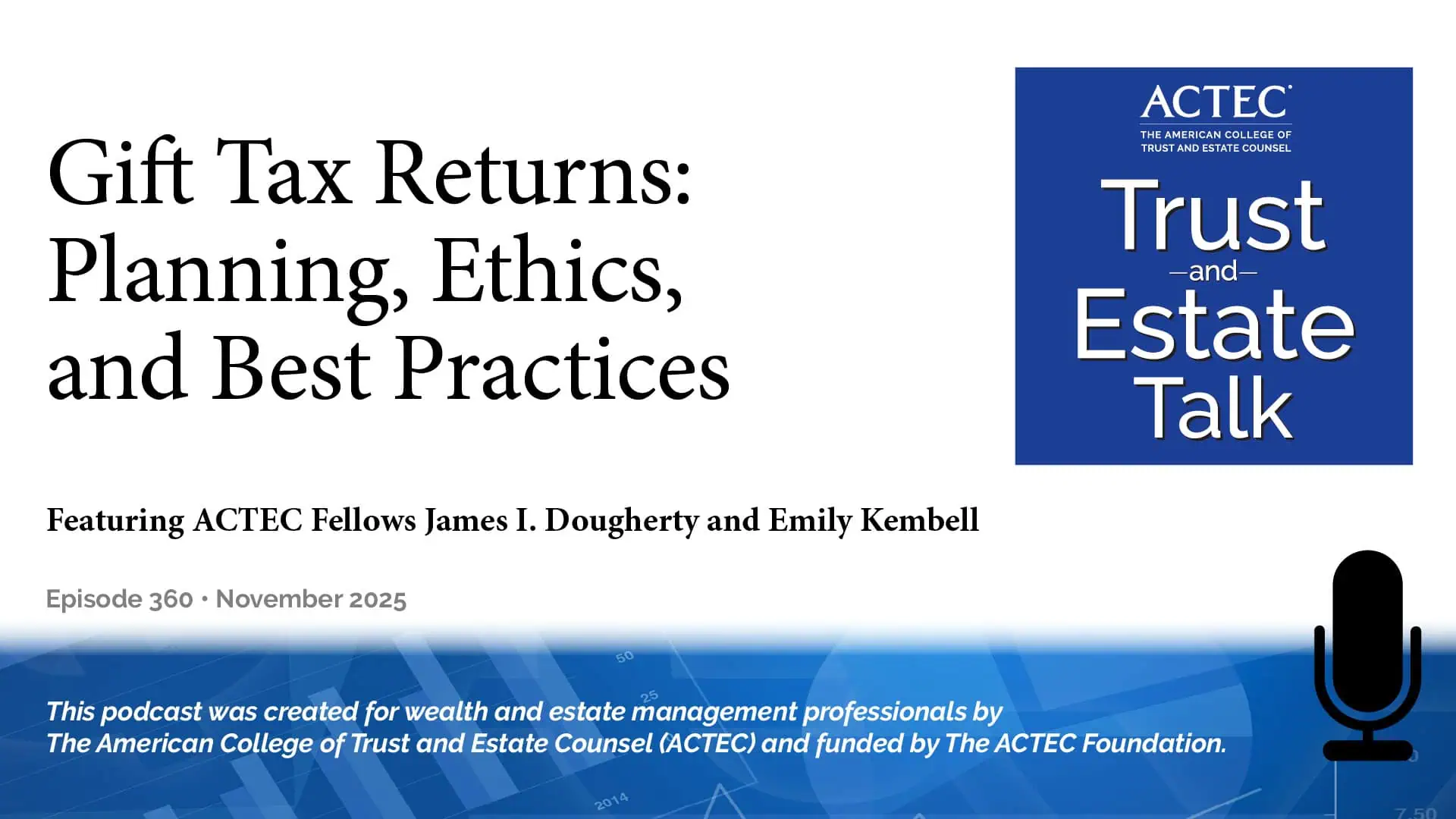
Gift Tax Returns: Planning, Ethics, and Best Practices
Learn about Form 709-NA, e-filing updates, gift splitting, digital assets, and disclosure rules in this ACTEC podcast on gift tax returns.
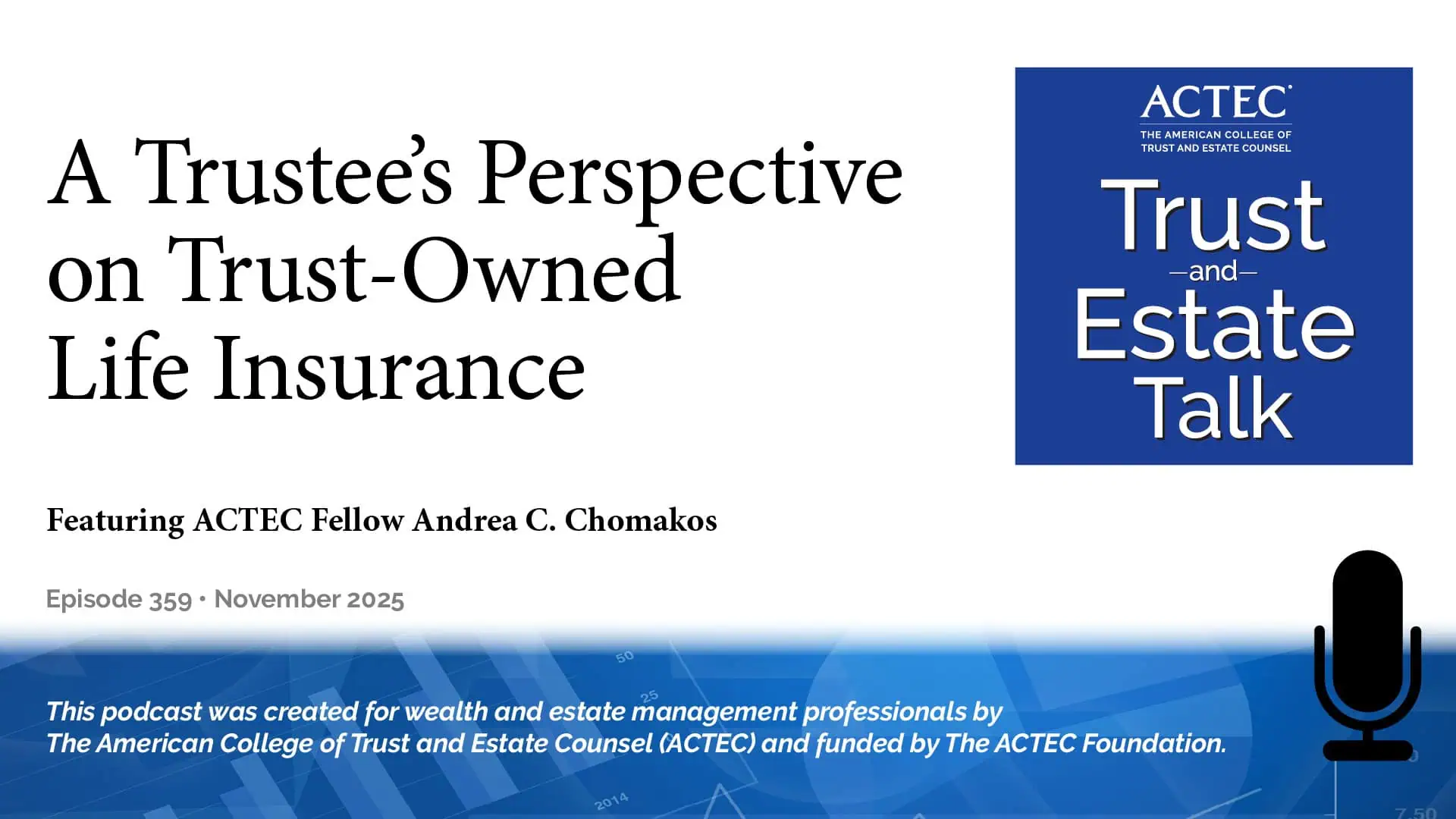
A Trustee’s Perspective on Trust-Owned Life Insurance
Learn key considerations for trustees managing Irrevocable Life Insurance Trusts (ILITs) and how to navigate grantor rules and withdrawal rights.
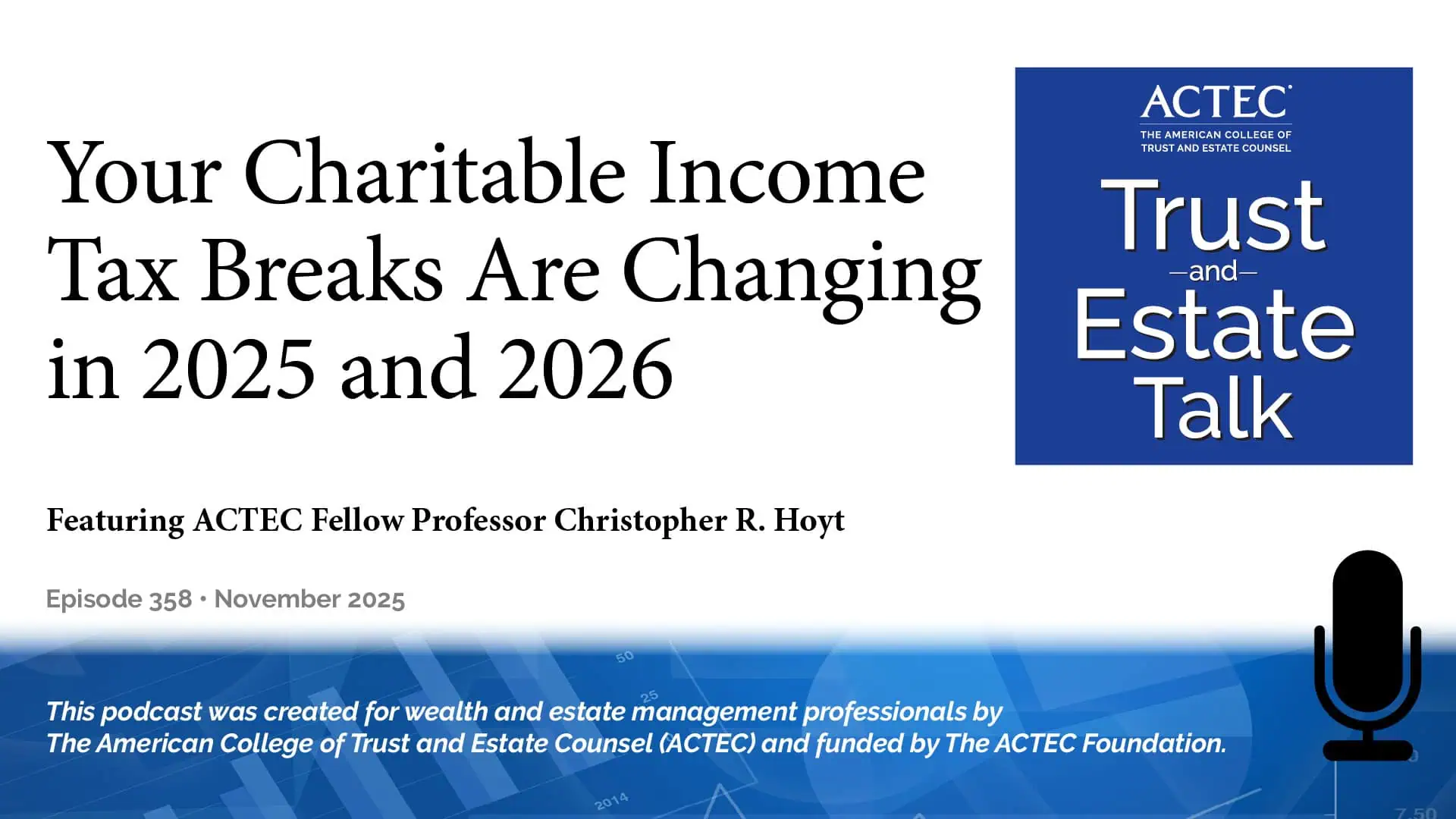
Your Charitable Income Tax Breaks Are Changing in 2025 and 2026
Learn how 2025–2026 tax changes impact charitable deductions, DAFs, and SALT limits, plus smart year-end giving and IRA gift strategies.

